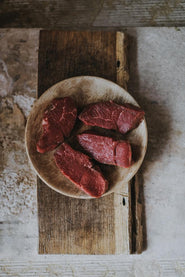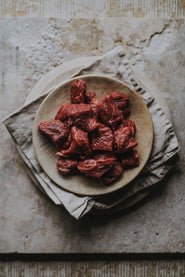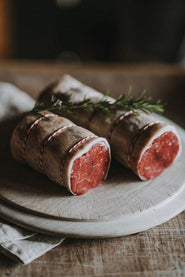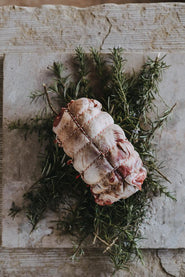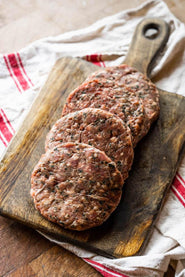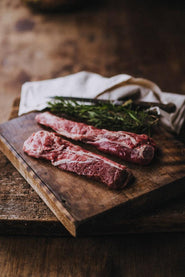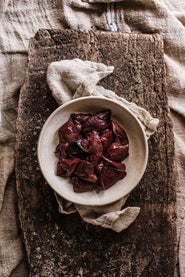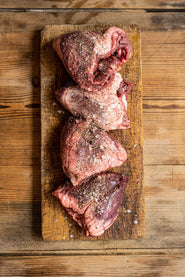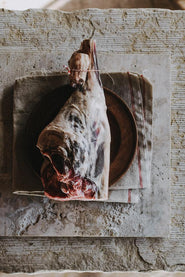Today is officially the first day of spring, although strangely on the farms it has felt like spring for some time. The mild winter has brought forward many signs of the new season, from blossom and buds on trees to a spread of floral carpets along every lane.
This morning we are heading off to the edge of Dartmoor, famed for its wild rugged beauty. The moorland looks particularly fine this morning, with a perfect display of yellow posies scattered in clumps across the mostly barren terrain. As we chug down the lanes in the old Landy, it’s just warm enough for the windows to be at half mast, filling the cab with the unmistakable vanilla-coconut scent of wild gorse growing thick and wild through the ancient hedgerows.
Our destination is a 15th Century farm just a stones throw from what the locals call ‘proper’ Dartmoor, where this farming family is engrossed in one of the countryside's most magnificent spectacles, lambing.
This farm has been a crucial part of this landscape for generations, with the Pellow family inhabiting the land since before records began. David and Linda Pellow, the farms current custodians, haven’t always lived here, although their name would suggest otherwise. The farm was sold out of the family line many years ago. David grew up on the hill overlooking their ancestral family home, at arms length.
“It came up for sale about 25 years ago.” Linda tells me. “We just knew we had to buy it, of course we couldn’t afford it at the time, but we did everything to make it work, and here we are today”.
David and Linda just like the old stone barns are so intwined with this landscape, fitting like hand to glove. Like many family farms, it’s hard to imagine this being anyone else’s home.

We meet David, who greets us with a warm smile and a look of pride in his eyes. In the trailer behind him sits a rather dignified ewe with her two healthy youngsters. David is on his way to turn her out in the field with the rest of the maternity ward. This is a trip he will do several times a day during lambing season.

Lambing has been an integral part of the success of pastured farmland areas like Devon for hundreds of years. Over recent years though, we have been pleased to see programmes such as ‘Lambing Live’ and ‘Countryfile’ help connect viewers at home with real life on the farm and shed a little bit of light on the realities of sheep farming.
Lambing is an exceptionally busy time for farming families, it is unrelenting and requires everyone to be on their ‘a-game’ to ensure the season runs smoothly. Once the sheep have successfully ‘tupped’ it’s important to regularly check the ewes to ensure they have enough grass and are safe and well. This is referred to as ‘lookering’ and is carried out several times a day by the Shepard, in this case both David and Linda, on foot and in, as Linda describes it “My favourite toy” her 4x4 quad-bike.

When a Ewe is with lamb, nutrition is incredibly important to ensure the health of both mother and her offspring. Deep-rooted pasture full of ‘5 a day’ nutrients make the best food for Ewes to convert into energy for growing their embryonic lambs. David and Linda will regularly move the mothers around the farm to maintain the right amount of food and allow the pasture to continue to grow. For any mothers in the nursery barns, they will have cut hay as their nourishment.
Everything is calculated like a military operation on the farm. About 10 weeks before the Ewes are due to lamb they are scanned to determine the lambing percentage. David and Linda will mark the Ewes with a colour spray paint to determine whether they are carrying singles, doubles or triplets. The expectant mothers will then be sorted into corresponding groups.
The mothers carrying triplets, or as Linda lovingly refers to them as the usual “Multiple offenders” will not rear all three babies, as this will often put too much strain on the mother and her milk resources, instead, the third lamb will be adopted by a mother with a single. This has to be done very carefully to make sure the new mother successfully adopts the second baby as her own.
Linda also incredibly rears any extra single lambs by hand, with a brilliant bottle feeding operation. Last year she proudly tells me she hand-reared 40 young lambs, once weened she was able to turn them out into the field with the other stock with no fuss. This just goes to show what a fantastic Shepard Linda truly is.
“I treat them like my children really. I know all their names and I understand what they need.”

On this magical farm most of the sheep will lamb outside in the field without any need for intervention, with regular ‘lookering’ David and Linda keep an expert eye on each mothers progress. I ask Linda how she knows when a ewe is about to lamb. She describes the usual signals; laying down, panting and the ewe’s udders bulging with milk, but it is her deft description of the connection between Shepherd and sheep that heartens me “They have a sort of ‘inward looking eye’. Instead of concentrating on munching the grass, you can see the mothers start to focus on what's happening inside. You can see it in their eyes. The anticipation of giving birth. That’s when I know she’s on her way".
Our hardy North of England Mules make excellent mothers, they are capable of lambing healthy offspring with minimum fuss. Once the Ewes have given birth they will ‘mother’ the newborn by licking their new babies completely clean. After a few minutes, the newborns will gainly wobble up on their new legs and stumble towards their mothers to suckle the vital colostrum (the first and incredibly nutrient-rich milk a new mother produces) from her full udder.

Farming is real life and there are occasions when things don’t go as smoothly, requiring David and Linda to intervene by helping with the delivery.
While we were out ‘lookering’ an example of this happened right before our eyes. We came across a lovely new lamb happily bleating next to her mother. However, her mother had two dots, meaning she was due to have two babies. David gave the Ewe a quick look over and realised she had been trying to lamb her next baby but the youngster had managed to get his foot trapped, leaving the Ewe struggling to push him out naturally.
David carefully manoeuvred the Ewe onto her back then skilfully and attentively, with just the right amount of expert force, was able to release the lamb from his mother, then right before us was a brand new life. Incredible.


Mother and sister began carefully inspecting the new babe. The natural instincts of the mother Ewe were plain to see, she kicked straight into her job of nursing her offspring encouraging her elder onto her teats while she juggled feeding, cleaning and nurturing her new family.

Once the Ewes have begun lambing, the work doesn’t just stop there. The new flock is vulnerable to predators like foxes which means the checks on the nursery are increased. Linda and David will rush between feeding, lookering, birthing, adopting, nurturing and turning out the young stock. They will act as midwives and parents to ensure the health and wellbeing of their 400 strong flock.
I have simply the greatest respect for this incredible couple who are truly nurturing the countryside in the heart of Devon. Supporting small-scale, traditional family farming, where those involved truly respect nature is so vital for the sustainability of our countryside, and especially for the sustainability of the communities of people who every day make tiny miracles happen.
Watch more...

